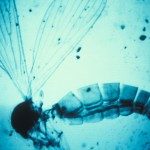Link to Pubmed [PMID] – 29551139
Adv. Virus Res. 2018;100:247-278
The use of Drosophila as a model organism has made an important contribution to our understanding of the function and regulation of innate immunity in insects. Indeed, insects can discriminate between different types of pathogens and mount specific and effective responses. Strikingly, the same pathogen can trigger a different immune response in the same organism, depending solely on the route of infection by which the pathogen is delivered. In this review, we recapitulate what is known about antiviral responses in Drosophila, and how they are triggered depending on the route and the mode used for the virus to infect its host.

